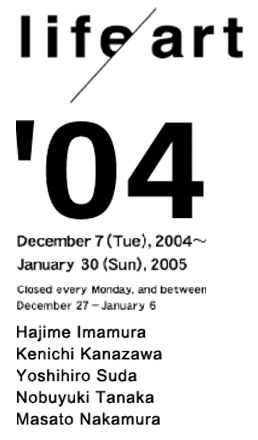- TOP
- Exhibition
- Past Exhibition
- 2004

The exhibition "life/art," presents new works by the same five artists, Hajime Imamura, Kenichi Kanazawa, Yoshihiro Suda, Nobuyuki Tanaka and Masato Nakamura, for a period of five consecutive years, with the aim to reanalyze the established concepts of art and craft. The series, which began in 2001, has a unique style, that of choosing one main artist who sets a theme for that year, along which the other four artists create their own works. For this fourth year, Hajime Imamura will take the initiative and collaborate with the other four artists.
An "artist" and an "artisan" are the same in the sense that both are creators, but while the "artist" has the ability to imagine freely and depend on his own creativity, and "artisan" in principle, must respond to orders and are thus not entirely free to use his imagination. For example, an "artist" may be allowed to create an object that is shaped like a chair (and even one that may not be functional) but a furniture upholsterer will only be allowed to create what his client requests him to make. He would not be considered an "artisan" if the chair failed to function as one. Of course, with the case of public art, "artists" are indeed commissioned to create certain works, but in this case also, he is asked to create not just the resulting object perse, but also the concept itself. Hence, in this case also, the artist is different in nature than that of an artisan. However, this differentiation between an "artist" and "artisan" only began with the advent of modernism and consequently the germination of individualism. This was a new notion that was unseen before. In Japan, the concept of fine arts came in from Europe after the Meiji Restoration. It was at this time when people became conscious of such demarcation. In other words, the idea of the "artist" is a product of modernity.
On this occasion, Imamura will attempt to question the nature of an artist through collaborations with the other four artists. For example, with Yoshihiro Suda, Suda will order Imamura to create a "desk," while Imamura will order Suda to make "ferns." Suda will place his work on Imamura's desk and Imamura will create a piece that incorporates Suda's fern. For both, the latter part of this collaboration is the work of an artist, but the first part would be very close to the work of an artisan, for it depends on craftsmanship. Thus, inherent in this one collaborative work is an artistic element as well as an element of craftsmanship. With his collaboration with Kenichi Kanazawa, Imamura will create a video piece for the first time. The video is of Kanazawa's signature work, "Vibratile Shape" (which is a steel sheet that makes sound when rubbed). With Imamura's participation, Kanazawa's work takes on a new style that is decidedly different from previous records of the work. In this case, Kanazawa and his work "Vibratile Shape" are Imamura's materials, which may make one think that Imamura takes the principle role and Kanazawa is the subordinate, but in some parts of the video, Imamura also acts according to Kanazawa's requests, thereby upending their relationship. In the first place, the idea to use video as a medium came from the discussion between the two, meaning that the collaborative process took place from the thinking stage, i.e. the artistic stage. There will be other collaborations taking place, some of which are beyond the usual styles of each of the artists, such as Nobuyuki Tanaka brushing lacquer over a rice ball that Imamura made himself. There will be four collaborations in total, filling up the gallery space. We hope this exhibition will provide viewers with the opportunity to think about the nature of the artist and of collaboration itself.
life/art '05│life/art '04│life/art '03│life/art '02│life/art '01